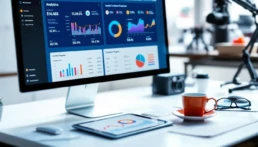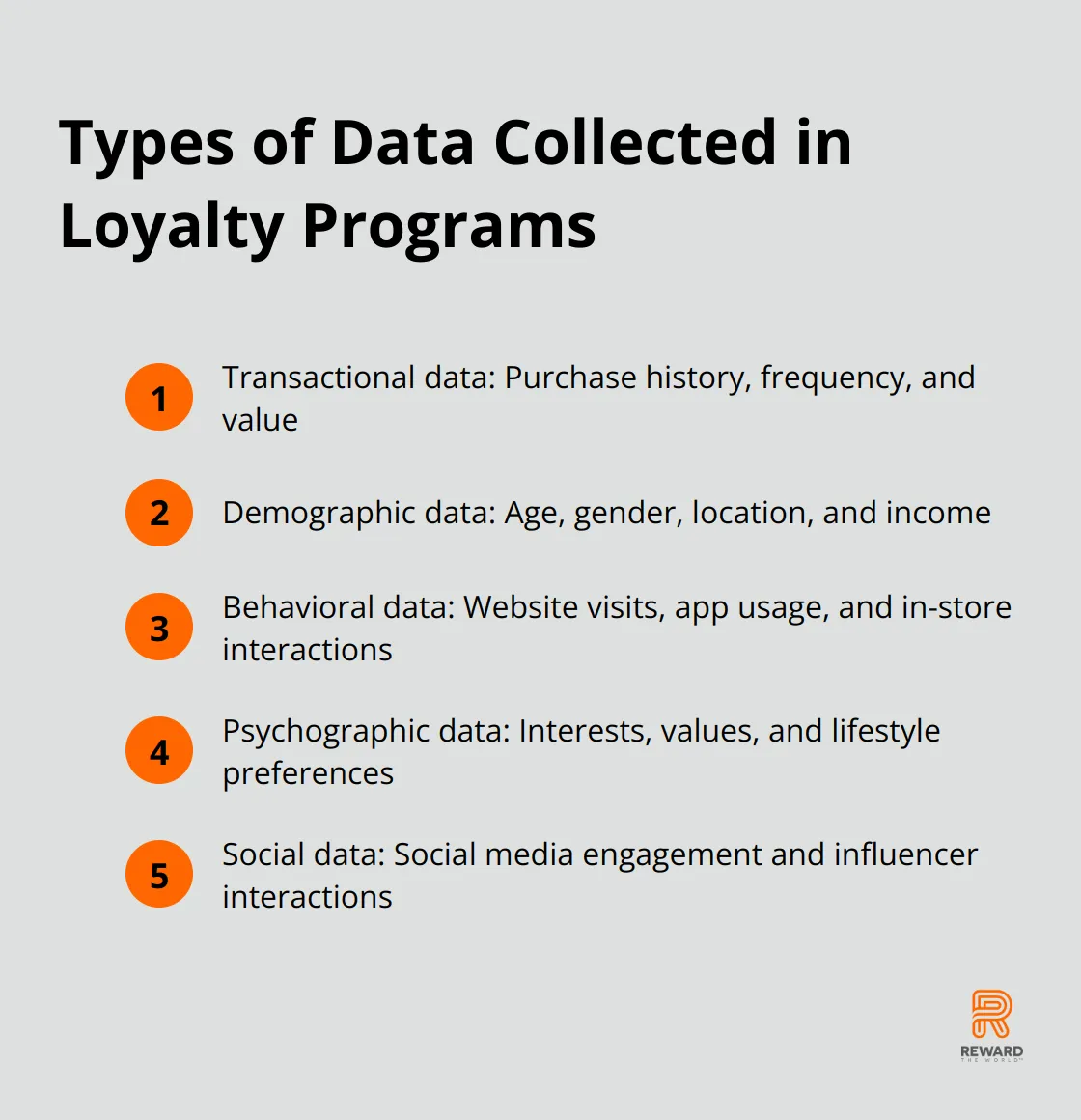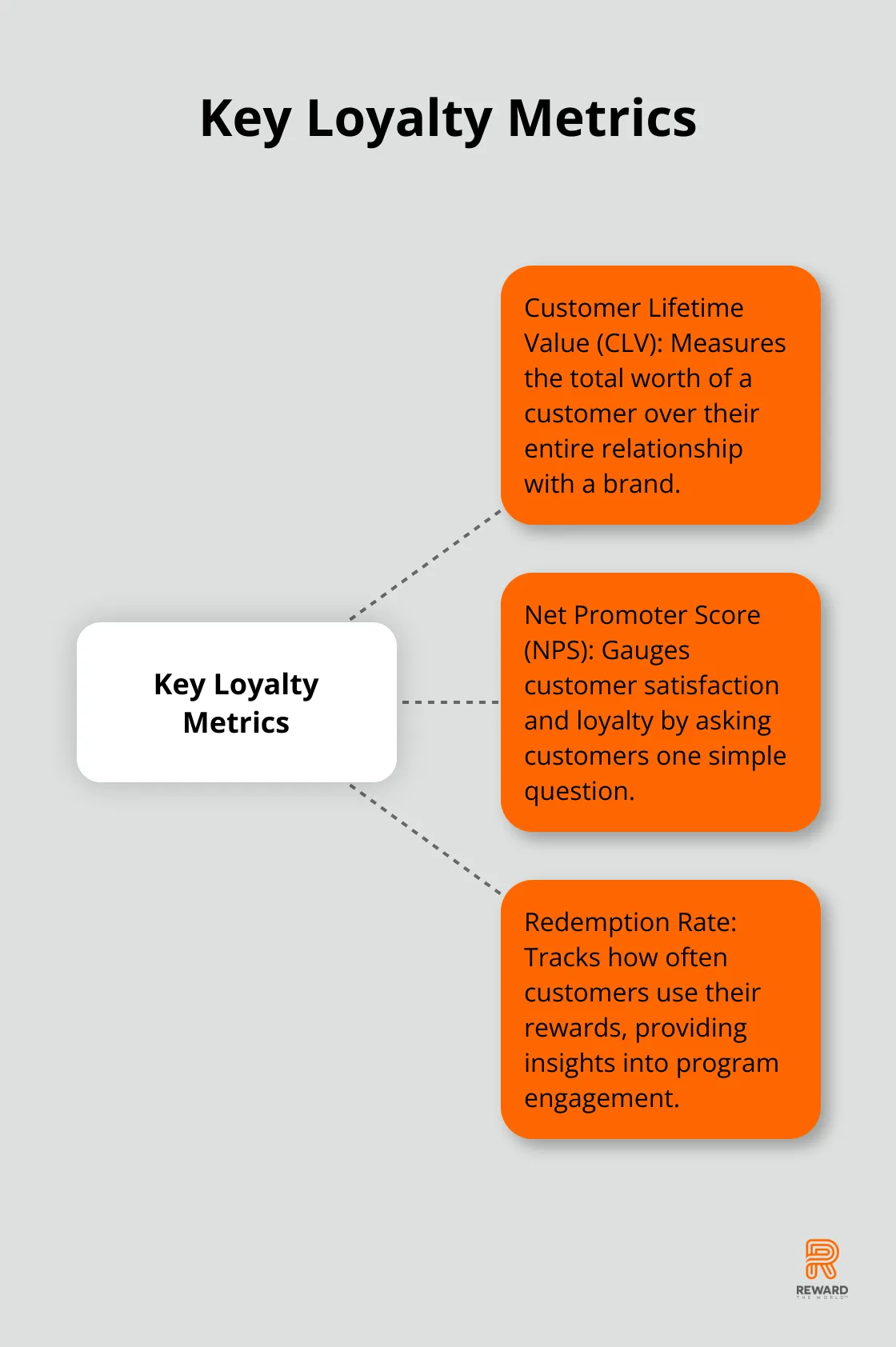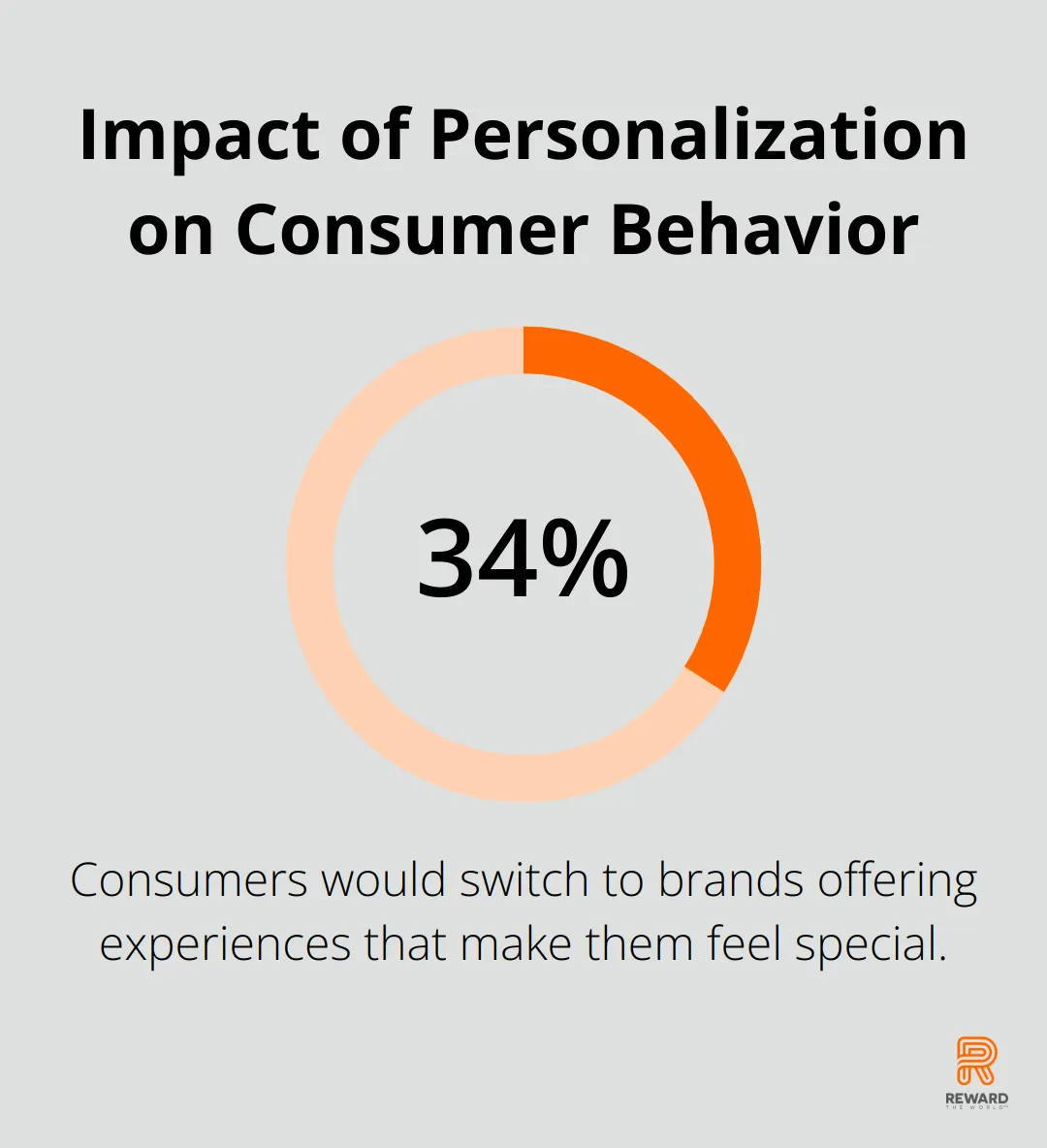
Big data has revolutionized the way businesses approach customer loyalty. At Reward the World, we’ve seen firsthand how harnessing vast amounts of customer information can transform loyalty programs.
Loyalty analytics allows companies to turn raw data into actionable insights, driving personalized experiences and boosting customer retention. This blog post explores how businesses can leverage big data to create more effective, data-driven loyalty strategies.
How Big Data Powers Customer Loyalty
The Scope of Big Data in Loyalty Programs
Big data has become the backbone of successful customer loyalty programs. By leveraging data analytics, businesses can unlock valuable insights into customer behavior, create personalized loyalty programs, and improve retention rates. This has led to an explosion in data collection, with loyalty programs now tracking everything from purchase history and browsing behavior to social media interactions and location data.
Types of Data Collected in Loyalty Programs
Loyalty programs collect a wide array of data points:

Enhancing Customer Understanding Through Big Data
Big data analytics transforms raw information into actionable insights. RFM (Recency, Frequency, Monetary) analysis, for example, helps segment customers into high-value, at-risk, and growth-potential categories. This segmentation allows for more strategic targeting and personalized experiences.
McKinsey reports that by better integrating their loyalty programs with pricing strategies, consumer-facing businesses can drive growth in a muddled economic landscape. These predictive models use historical data to forecast future customer behavior, enabling businesses to tailor offerings proactively.
Real-World Applications of Big Data in Loyalty
Starbucks successfully uses data analytics to personalize rewards, which increases customer retention within its Rewards program. They analyze purchase history, location data, and app usage to send targeted offers and suggestions to their customers.
Amazon leverages the wealth of data collected from Prime members to provide highly personalized shopping recommendations and targeted advertising. This approach enhances the shopping experience and boosts loyalty through its Prime program.
While these giants set impressive benchmarks, platforms like Reward the World make similar capabilities accessible to businesses of all sizes. Reward the World processes data from 250 million users across 15 languages, offers instant reward delivery, and provides robust analytics to elevate customer engagement and boost company performance.
The Future of Big Data in Loyalty Programs
As we move forward, the role of big data in loyalty programs will only grow. Artificial Intelligence (AI) and Machine Learning (ML) will play an increasingly important role in processing and analyzing this data. These technologies will enable even more sophisticated predictive modeling and personalization strategies.
However, with great power comes great responsibility. As businesses collect and utilize more customer data, they must also prioritize data privacy and security. Compliance with regulations like GDPR will be essential for maintaining customer trust and loyalty.
The next frontier in loyalty programs will involve turning these vast amounts of data into actionable insights. Let’s explore how businesses can transform raw data into strategies that drive customer loyalty and business growth.
Turning Data into Loyalty Gold
Identifying Key Loyalty Metrics
Successful loyalty programs track specific metrics to gauge their effectiveness. Customer Lifetime Value (CLV) measures the total worth of a customer over their entire relationship with a brand. It is a crucial metric for promoting customer loyalty and increasing profits.
The Net Promoter Score (NPS) measures customer loyalty, satisfaction, and enthusiasm with a company. It is calculated by asking customers one question and is used to gauge customer satisfaction and loyalty.
Redemption rate tracks how often customers use their rewards, providing insights into program engagement. A low redemption rate might indicate unappealing rewards or a complex program. Starbucks maintains a high redemption rate by offering easily attainable and desirable rewards.

Advanced Analysis Techniques
Businesses use sophisticated analysis techniques to extract meaningful insights from loyalty data. Predictive analytics forecasts future customer behavior using historical data. A retail chain might use predictive models to identify customers at risk of churning, allowing for timely intervention with personalized offers.
Sentiment analysis of customer feedback provides valuable insights into program satisfaction. Analysis of comments, reviews, and social media posts helps businesses identify areas for improvement and address issues proactively.
Cohort analysis groups customers based on shared characteristics or experiences. This technique can be applied to loyalty and referral programs to gain valuable insights.
Powerful Tools for Data Processing
Robust tools handle the vast amounts of data generated by loyalty programs. Cloud-based platforms like Amazon Web Services (AWS) and Google Cloud Platform offer scalable solutions for data storage and processing.
Data visualization tools (such as Tableau and Power BI) transform complex data sets into easily understandable visual representations. These tools allow businesses to spot trends, patterns, and anomalies quickly, facilitating faster decision-making.
Machine learning platforms like TensorFlow and scikit-learn enable businesses to build and deploy sophisticated predictive models. These tools automate the process of identifying high-value customers, predicting churn, and personalizing rewards.
While these tools are powerful, they can be complex to implement and manage. Platforms like Reward the World offer built-in analytics capabilities that make it easy for businesses of all sizes to leverage advanced data processing techniques without extensive technical expertise.
Putting Insights into Action
Data’s true value lies in its application. Businesses that successfully leverage loyalty insights often see significant improvements in customer retention and program engagement. Sephora’s Beauty Insider program uses purchase history data to offer personalized product recommendations, contributing to its high customer retention rate.
Starbucks uses its loyalty app data to optimize store locations and inventory, ensuring popular items are always in stock at the right locations. This data-driven approach has helped Starbucks maintain its position as a leader in the competitive coffee market.
The next step in maximizing the potential of loyalty programs involves implementing these insights to create personalized, targeted strategies that drive customer engagement and boost retention. Let’s explore how businesses can turn these valuable insights into effective loyalty-building actions.
How to Turn Loyalty Insights into Action
Personalization at Scale
Personalization has become a necessity, not a luxury. Accenture reports that 34% of consumers would switch to brands that offer experiences that make them feel special. This statistic underscores the importance of tailored experiences.

To achieve effective personalization, segment your customers based on their behavior, preferences, and purchase history. Use RFM (Recency, Frequency, Monetary) analysis to categorize customers into high-value, at-risk, and growth-potential groups. This segmentation allows for more targeted marketing efforts.
A high-value customer who hasn’t made a purchase in 30 days might receive a personalized email with exclusive offers on their favorite products. An at-risk customer could receive a survey to understand their concerns, followed by a special discount to encourage re-engagement.
Predicting Customer Behavior
Predictive modeling transforms loyalty programs. Analysis of historical data enables forecasts of future customer actions, allowing businesses to tailor their strategies accordingly.
Identify key indicators of customer churn, such as reduced purchase frequency, lower engagement with communications, or negative feedback. Use these insights to create an early warning system for at-risk customers.
If a customer’s engagement score drops below a certain threshold, trigger a re-engagement campaign automatically. This campaign could include personalized content, exclusive offers, or even a direct outreach from a customer service representative.
Real-time Optimization
The ability to make real-time decisions is essential in today’s fast-paced market. Implement systems that allow for immediate adjustments to your loyalty program based on customer behavior and market trends.
A sudden spike in interest for a particular product category should prompt quick adjustments to rewards offerings to capitalize on this trend. If a competitor launches a new promotion, swiftly counter with your own targeted offer to high-value customers.
Real-time personalization based on customer interactions can significantly improve experiences and drive loyalty. Epsilon’s study found that consumers’ feelings about a brand, more than need, drive stronger engagement with marketing.
Continuous Testing and Refinement
The key to successful implementation lies in ongoing testing and refinement. Analyze the performance of your personalized campaigns, predictive models, and real-time optimizations regularly. Use A/B testing to compare different approaches and improve your strategies continuously.
Leverage these insights effectively to create a loyalty program that not only retains customers but turns them into brand advocates. This approach can lead to increased customer lifetime value, higher retention rates, and a stronger bottom line for your business.
Choosing the Right Platform
Selecting the right platform to implement these strategies is critical. While many options exist, Reward the World stands out as a top choice. With its massive user base (250 million users across 15 languages) and instant reward delivery capabilities, it provides businesses with the tools needed to implement personalized, data-driven loyalty strategies effectively.
Final Thoughts
Big data has transformed loyalty programs, enabling businesses to understand and engage customers in unprecedented ways. Loyalty analytics now allows companies to create personalized experiences that drive customer retention and boost overall performance. The future of data-driven loyalty looks promising, with artificial intelligence and machine learning poised to enable even more sophisticated predictive modeling and personalization strategies.
Companies must prioritize ethical data practices and compliance with regulations to maintain customer trust in an increasingly data-driven world. Businesses should assess their current data collection capabilities, implement robust analytics tools, and develop a data-driven culture within their organization. They should focus on turning insights into action through personalized marketing campaigns, tailored product recommendations, and optimized customer service experiences.
Reward the World offers businesses the ability to harness the power of big data for loyalty. With its user base, reward delivery, and analytics capabilities, Reward the World provides a solution for companies aiming to elevate customer engagement and boost performance. Success in the age of big data depends on the ability to turn raw information into actionable insights.
